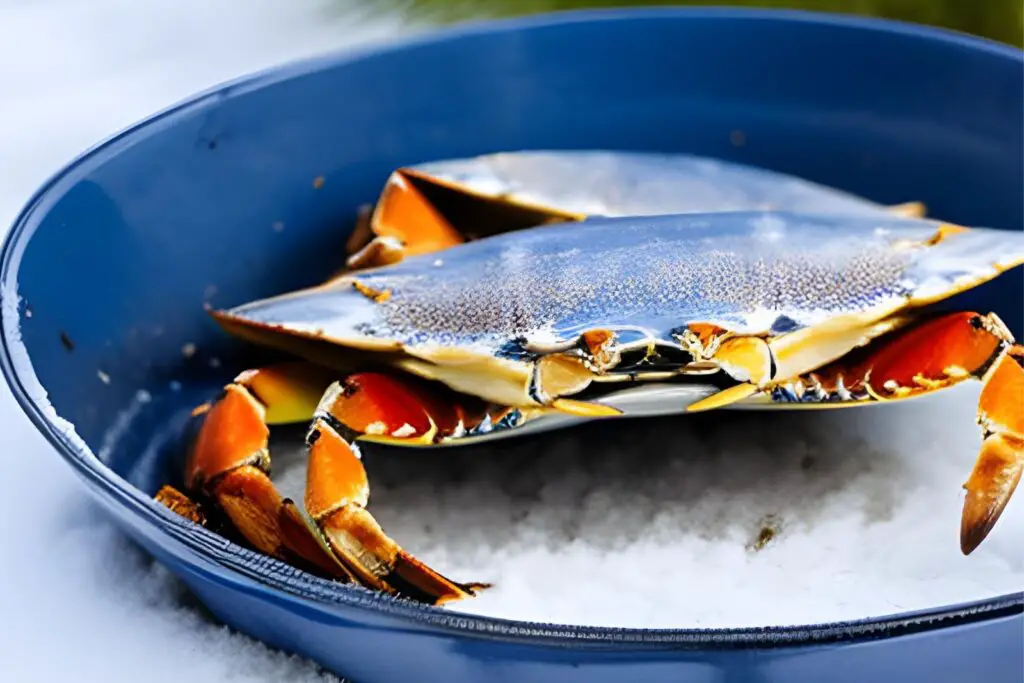
Lox is a popular delicacy made from the brined and smoked fillets of salmon. It is commonly enjoyed on bagels with cream cheese, onions, and capers. Lox can be quite expensive, so it’s essential to know how to properly freeze it to extend its shelf life and enjoy it at your convenience. Freezing lox is a straightforward process that requires minimal effort but ensures the preservation of its texture and flavor. In this article, we will provide a step-by-step guide on how to freeze lox effectively, allowing you to savor its deliciousness whenever you desire.
Here’s a comprehensive guide on freezing lox:
Step 1: Purchase fresh lox
When it comes to freezing lox, starting with fresh and high-quality fillets is essential. The quality of the lox you choose will greatly impact the results you achieve when freezing and thawing it later on.
Fresh lox is characterized by its vibrant color and firm texture. Look for fillets that have a rich, deep color, ranging from reddish-orange to deep pink. Avoid lox that appears dull, discolored, or has a slimy texture, as these are signs of poor quality or possible spoilage.
Choosing fresh lox ensures that you are working with a product that has been properly handled and stored, minimizing the risk of bacterial growth and preserving its flavor and texture. High-quality lox will have a delicate yet firm texture, allowing it to maintain its shape and integrity during the freezing process.
Can I freeze lox directly from the store packaging?
In most cases, it is not recommended to freeze lox directly in its store packaging. Store packaging is typically not designed for long-term freezer storage and may not provide adequate protection against freezer burn or prevent the lox from absorbing odors from the freezer. It is best to transfer the lox to an airtight container or wrap it tightly in plastic wrap or freezer bags before freezing to maintain its quality and freshness.
Is it safe to freeze lox that has been opened but not consumed?
Yes, it is generally safe to freeze lox that has been opened but not consumed. However, it’s important to ensure that the lox is stored properly to maintain its quality and safety. Transfer the opened lox to an airtight container or wrap it tightly in plastic wrap before freezing to protect it from freezer burn and odors. Additionally, try to freeze it as soon as possible after opening to minimize the risk of bacterial growth.
Step 2: Portion the lox
Dividing the lox into individual portions based on your desired serving size is an important step in freezing lox. By portioning the lox before freezing, you ensure that you can thaw only the amount you need for a particular meal or occasion, without having to defrost the entire package.
Portioning the lox offers several benefits. First, it allows for better portion control and minimizes waste. If you freeze the entire package of lox without dividing it, you may end up thawing more than you need, leading to leftovers that might go to waste. By portioning the lox, you have the flexibility to take out only the required amount, reducing the chances of unnecessary leftovers.
Additionally, portioning the lox helps with the overall freezing and thawing process. Smaller portions freeze and thaw more quickly and evenly compared to a larger piece. This ensures that the lox maintains its quality and texture throughout the freezing and thawing stages.
To portion the lox, you can use a sharp knife to carefully divide it into individual serving sizes. Consider the number of people you will be serving or the quantity you typically consume in one sitting. You can separate the portions by cutting the lox into slices, fillets, or even bite-sized pieces, depending on your preference and intended use.
Once you have portioned the lox, it is important to package and store each portion separately to maintain its freshness and prevent freezer burn. This way, you can easily retrieve and thaw the exact amount of lox needed for a specific meal or snack, while keeping the rest of the portions safely frozen.
Step 3: Wrap the lox tightly
After portioning the lox, the next step is to wrap each individual portion tightly in plastic wrap. This wrapping process is crucial for maintaining the freshness of the lox and preventing freezer burn.
When you wrap the lox tightly in plastic wrap, you create a protective barrier that helps to preserve its flavor, texture, and moisture. This barrier prevents air from reaching the surface of the lox, which can lead to oxidation and the development of freezer burn. Freezer burn occurs when moisture evaporates from the surface of the food, resulting in dry, discolored patches that can affect the taste and quality of the lox.
To wrap the lox, start by placing the portion on a sheet of plastic wrap. Make sure the plastic wrap is large enough to fully enclose the lox. Gently fold one end of the plastic wrap over the portion, then tuck in the sides, and roll it up tightly, ensuring that the lox is completely covered. The goal is to create a snug and airtight seal around the lox.
By tightly wrapping the lox in plastic wrap, you create a barrier that prevents air from coming into contact with the lox’s surface. This helps to maintain its freshness, flavor, and texture during the freezing process. The plastic wrap also helps to prevent any odors from the freezer from being absorbed by the lox, preserving its natural taste.
Remember to label each wrapped portion with the date of freezing to keep track of its freshness. This will help you identify and use the oldest portions first when retrieving them from the freezer.
Step 4: Double-bag the lox
To enhance the protection and preservation of the frozen lox, it is recommended to double-bag the wrapped lox portions using resealable freezer bags. Double-bagging adds an extra layer of insulation and prevents odors from penetrating the lox, thereby maintaining its flavor and quality.
Resealable freezer bags are designed specifically for long-term storage in the freezer. They are thicker and more durable than regular plastic bags, providing better protection against freezer burn and moisture loss. By using these bags, you create a reliable barrier that helps to maintain the texture, taste, and freshness of the lox.
To double-bag the lox, follow these steps:
- Take the wrapped lox portion and place it inside a resealable freezer bag. Ensure that all the air is squeezed out of the bag before sealing it. Removing excess air reduces the risk of freezer burn and helps to maintain the lox’s quality.
- Once the first bag is sealed, place it inside a second resealable freezer bag. Again, squeeze out as much air as possible from the second bag before sealing it. This double-bagging technique provides an additional layer of insulation and further protects the lox from air exposure.
The double-bagging method is especially useful for preventing any odors from the freezer from seeping into the lox. Fish, being sensitive to odors, can absorb and retain unwanted smells if not properly protected. By double-bagging, you create an extra barrier that helps to isolate the lox from any potential odors in the freezer, preserving its natural flavor.
Remember to label each bag with the date of freezing, ensuring proper rotation and usage of the lox portions.
Double-bagging the lox provides an added level of protection, minimizing the risk of freezer burn, moisture loss, and unwanted odors. This step contributes to maintaining the lox’s flavor, texture, and overall quality throughout its storage in the freezer.
Step 5: Label the packages
Labeling the packages is an important step when freezing lox. By using a marker or adhesive labels to write the date of freezing on each bag, you can keep track of the lox’s freshness and ensure that it is consumed within the recommended time frame.
Freezing lox allows you to extend its shelf life, but it’s crucial to keep track of when it was frozen. Writing the date of freezing on each package provides a clear indication of how long the lox has been stored in the freezer. This information helps you prioritize the consumption of older packages, ensuring that you use them before the quality begins to degrade.
The date of freezing serves as a reference point for determining the lox’s freshness and helps you avoid consuming lox that has been stored for an excessively long period. While frozen lox can remain safe to eat indefinitely, its quality may gradually decline over time. By labeling the packages, you can follow recommended guidelines and consume the lox within the optimal timeframe for the best taste and texture.
When labeling the packages, use a marker or adhesive labels that adhere well to the freezer bags. Ensure that the date is written clearly and prominently, making it easy to read at a glance. Placing the label or writing the date on a visible area of the package will help you quickly identify and manage the storage of the lox.
Step 6: Store in the freezer
After double-bagging the lox portions, it’s time to store them in the freezer. Proper storage in the freezer is crucial for maintaining the quality and safety of the lox. Follow these steps to ensure optimal storage conditions:
- Choose the coldest part of your freezer: The coldest part of the freezer is typically towards the back or bottom. This area experiences the least temperature fluctuation when the freezer door is opened, providing a more stable environment for your lox.
- Set the temperature at or below 0°F (-18°C): It’s important to ensure that your freezer is set to a temperature of 0°F (-18°C) or below. This low temperature inhibits the growth of bacteria and other microorganisms, keeping the lox safe to eat. Additionally, the freezing temperature helps to maintain the texture and flavor of the lox over an extended period.
- Arrange the double-bagged lox portions: Place the double-bagged lox portions in a single layer in the chosen area of the freezer. Make sure they are arranged in a way that allows for proper airflow around each portion. Avoid overcrowding or squishing the packages together, as this can affect the freezing and thawing process.
It’s worth mentioning that maintaining a consistent temperature is crucial. Frequent fluctuations in temperature can negatively impact the quality of the lox, leading to potential texture and flavor changes. Avoid opening the freezer door unnecessarily and limit temperature variations as much as possible.
How long can I keep lox in the freezer?
Lox can be kept in the freezer for up to 2 to 3 months without significant loss in quality. However, for the best taste and texture, it is recommended to consume lox within the first month of freezing. Beyond that timeframe, lox may start to develop freezer burn, which can affect its flavor and texture. Proper storage in airtight containers or tightly sealed freezer bags can help maintain the quality of the lox for a longer period in the freezer.
Step 7: Thaw and consume
When the time comes to enjoy your frozen lox, it’s important to thaw it properly to preserve its taste and texture. Follow these steps to thaw and consume your lox:
- Remove from the freezer: Take the desired portion of frozen lox from the freezer. It’s best to only thaw the amount you intend to consume to avoid unnecessary waste.
- Transfer to the refrigerator: Place the frozen lox portion in the refrigerator to thaw slowly. This gradual thawing process helps maintain the quality of the lox. It is recommended to place the lox on a plate or in a covered container to prevent cross-contamination with other foods and to collect any liquid that may be released during thawing.
- Allow overnight thawing: Give the lox enough time to thaw properly by allowing it to remain in the refrigerator overnight. Thawing slowly at a controlled temperature ensures that the lox retains its moisture and doesn’t become overly soft or mushy.
- Consume within 1-2 days: Once the lox is fully thawed, it is best to consume it within 1-2 days for optimal taste and texture. This timeframe ensures that the lox maintains its freshness and doesn’t experience significant quality degradation.
Thawing the lox in the refrigerator is the recommended method as it maintains a controlled temperature environment, reducing the risk of bacterial growth. Thawing at room temperature or using quick thawing methods can result in uneven thawing and compromise the texture and flavor of the lox.
It’s essential to note that once the lox has been thawed, it should not be refrozen. Thawed lox is more susceptible to bacterial growth, and refreezing it can further impact its quality and safety.
Other related questions
Can I refreeze lox if I have thawed it once?
It is generally not recommended to refreeze lox after it has been thawed once. When lox is thawed, its texture and quality can be compromised, and refreezing it can further deteriorate its taste and texture. Additionally, the repeated thawing and refreezing process can increase the risk of bacterial growth and foodborne illness. It is best to thaw only the amount of lox you intend to use to minimize waste and maintain the best quality.
How do I know if my frozen lox has gone bad?
There are a few indicators that can help you determine if your frozen lox has gone bad. First, check for any signs of freezer burn, such as discoloration, dryness, or ice crystals forming on the surface. Secondly, if the lox has developed an off smell or an unpleasant odor, it is likely spoiled. Lastly, if the texture of the lox appears slimy, mushy, or significantly different from its original state, it is a strong indication of spoilage. If you notice any of these signs, it is best to discard the lox to avoid the risk of consuming spoiled food.
Can I use frozen lox with the fresh ones?
Yes, you can use frozen lox with fresh ones. When using both frozen and fresh lox together, it’s important to ensure that the frozen lox has been properly thawed in the refrigerator before combining them. This will allow for a more consistent texture and taste throughout the dish. However, keep in mind that the frozen lox may have a slightly different texture compared to the fresh one, so it’s best to consider this when planning your recipe or presentation.
Will freezing lox affect its texture or taste?
Freezing lox can potentially affect its texture and taste to some extent. The texture of lox may become slightly softer or more delicate after freezing and thawing. Additionally, there can be a subtle change in taste as freezing can impact the overall freshness of the fish. However, if properly stored and thawed, the difference is often minimal, and many people still find the frozen and thawed lox enjoyable.








